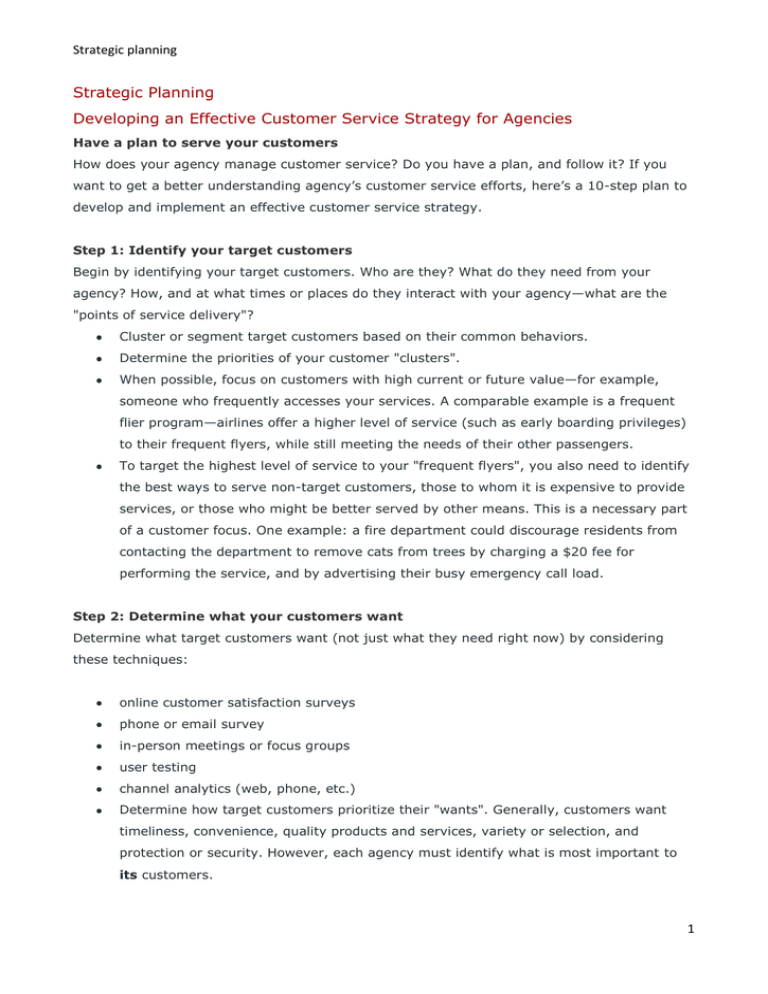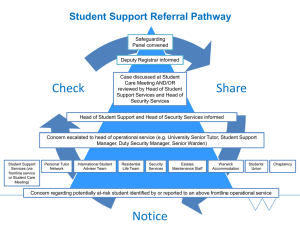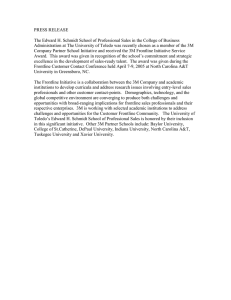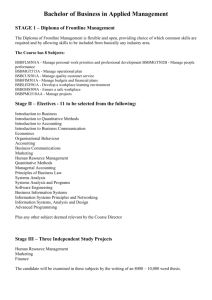Strategic Planning Developing an Effective Customer Service
advertisement

Strategic planning Strategic Planning Developing an Effective Customer Service Strategy for Agencies Have a plan to serve your customers How does your agency manage customer service? Do you have a plan, and follow it? If you want to get a better understanding agency’s customer service efforts, here’s a 10-step plan to develop and implement an effective customer service strategy. Step 1: Identify your target customers Begin by identifying your target customers. Who are they? What do they need from your agency? How, and at what times or places do they interact with your agency—what are the "points of service delivery"? Cluster or segment target customers based on their common behaviors. Determine the priorities of your customer "clusters". When possible, focus on customers with high current or future value—for example, someone who frequently accesses your services. A comparable example is a frequent flier program—airlines offer a higher level of service (such as early boarding privileges) to their frequent flyers, while still meeting the needs of their other passengers. To target the highest level of service to your "frequent flyers", you also need to identify the best ways to serve non-target customers, those to whom it is expensive to provide services, or those who might be better served by other means. This is a necessary part of a customer focus. One example: a fire department could discourage residents from contacting the department to remove cats from trees by charging a $20 fee for performing the service, and by advertising their busy emergency call load. Step 2: Determine what your customers want Determine what target customers want (not just what they need right now) by considering these techniques: online customer satisfaction surveys phone or email survey in-person meetings or focus groups user testing channel analytics (web, phone, etc.) Determine how target customers prioritize their "wants". Generally, customers want timeliness, convenience, quality products and services, variety or selection, and protection or security. However, each agency must identify what is most important to its customers. 1 Strategic planning Weigh how important the customer-identified "wants" are to your agency. Are the services something that the organization does, is capable of doing, or wants to pursue? Determine how well your agency can meet your customers' "wants" in comparison with competitors. You may think you don’t have competitors, but more than likely you do, especially if you're producing consumer-related information for the public. Be mindful of who's doing similar work—if competing organizations meet or exceed customer expectations, it changes the customer's frame of reference and increases their expectations. Step 3: Create a culture of customer service Determine which "wants" would most positively impact your agency's bottom line (for example, increased compliance with a regulation, more loyalty and trust, or a desired customer behavioral change), and whether those "wants" should be targeted for improvement In the best performing private companies, CEOs ensure that employees at all levels understand their customers and are given the tools to serve them well. Agency leadership must communicate the importance of customer service and ensure that all employees, even those without direct customer-facing jobs, understand how their work serves customers. Management must regularly interact with customers so they understand evolving customer needs. Most importantly, front-line customer service workers must be empowered to actually solve problems on the spot. Step 4: Clearly communicate service standards and expectations Set service standards, such as call wait times, claims processing times, and satisfaction ratings. Clearly define the standards and make them publicly available. Clearly defined goals helps motivate employees and helps manage customer expectations. When service standards cannot be met, customers must be informed—a non-negotiable best practice in the private sector. Step 5: Provide consistent service across channels Agencies should continuously collect comprehensive customer feedback across the whole customer experience—not just via each channel. As communication preferences change, we need to adapt our services to interact with our customers, when and how they prefer. 2 Strategic planning Consistency of service across channels is critical—a customer who gets an answer on the phone should receive the same answer in-person at a local office, via the website, over email, or via mobile device. Step 6: Establish a vision for customer service excellence Establish your agency's customer-focused vision using all the information in these steps. The vision statement should be simple and may also identify what the company does not want to be. Sample vision statements include: Continually reflect on the vision and goals and the way services you're delivering service. Be creative about the ways you create and deliver new services. Be willing to change existing practices to integrate improvements. Live up to what you promise by applying both an external and internal strategy that reflect the vision. If your agency doesn't implement both internally and externally oriented strategies consistent with the vision, you'll have good intentions but poor customer service. Step 7: Implement an external strategy The external strategy should focus on how your agency's service is designed, marketed, and delivered to target customers. Take into account the costs of providing services and ways to minimize those costs while implementing quality control. Develop the service concept with the frontline worker at its center. Determine the necessary financial, human, and technological resources, as well as how your agency structure and flow can enable frontline workers to deliver excellent customer service. Use educational strategies to set appropriate customer expectations. Provide a feedback loop to incorporate customer comments and complaints into the planning process. Customer complaints are an invaluable resource. Without them, organizations can't be successful. Complaints that people bring to your agency are one of the most efficient and least expensive ways to get information about people's expectations of your agency and its products and services. Studies have shown that customer comments and complaints are a more direct means of getting information than conducting research studies of customer expectations, conducting transaction studies, or reviewing customer expectations in similar industries. Ensure that the complaint resolution strategy supports the customer-focused vision. Most research shows if customers believe their complaints are welcomed and responded to, they will more likely come back to your organization for a future interaction. 3 Strategic planning Step 8: Focus on recruiting and retaining good employees While Step 7 outlined an external strategy, the next three steps cover, in detail, the internal strategy—how your agency’s internal processes will support the customer-focused vision. The premise is that "capable workers who are well trained and fairly compensated provide better service, need less supervision, and are much more likely to stay on the job. As a result, their customers are likely to be more satisfied…" (Harvard Business Review, 1994). Research also shows that employee turnover and customer satisfaction are directly correlated—typically, the higher the turnover rate, the lower the agency scores in delivering good service. In addition, it's commonly noted that employee turnover is an expensive problem, with significant costs needed to hire and train new people. Leaders must foster the creation and testing of new ideas and be openly willing to change existing practices to integrate improvements. Learn how targeted employees perceive the proposed customer services. An organization cannot change without the participation of its employees. Focus on recruiting employees who support the customer service vision. The costs of employing people who do not support the customer service vision are considerable. In addition, develop career paths that allow successful customer-oriented employees to remain on the frontline. Step 9: Empower employees to resolve customer service problems Empower frontline employees to do what it takes to satisfy the customer. Management must support employee empowerment by clearly defining the boundaries of the empowerment, while remaining flexible within those boundaries. This will encourage creativity. In general, rules should be simple and few—Continental Airlines actually had an employee handbook burning party to signify the change from a procedural environment to one of empowered customer service (Spector, 2001). In addition to skills and empowerment, equip frontline personnel with the technology, information, and internal resources to do what it takes to satisfy your customers. Step 10: Develop good communications and rewards system Ensure that directorates and individuals within your agency communicate. Frontline employees who take customer questions, and other employees who have answers to those question, need a support network. A customer should never have to tell one employee what another employee already knows. Develop cross-functional teams for operations and improving service. Ask the people who are doing the work for suggestions to improve productivity. 4 Strategic planning Link employees' compensation to (and offer rewards for) good customer service performance. Rewards can be money, status, praise, acknowledgement, or perks such as trips, time off, or special events. Finally, measure employee satisfaction regularly. 5



